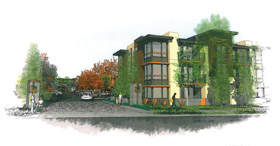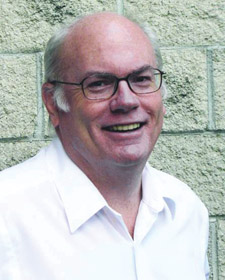A housing shortage, rising rents and inflated home prices are tough on working families.
Prices skyrocket
Heidi Pay, COO and general manager of Decker Bullock Sotheby’s International Realty in Mill Valley, says the increasing demand and limited supply of homes in the Bay Area has resulted in a minimum qualifying annual income of $270,000 is needed to buy a median-priced home in San Francisco: “That really illustrates the housing imbalance.”
Pay refers to the newest figures compiled by the California Association of Realtors (CAR). CAR statistics from 2015 indicate the minimum qualifying income to purchase a median-priced home in Marin County is $231,470. In Napa County, it’s $123,000 and $112,000 in Sonoma County. By comparison, statewide it requires $96,000 in annual income; in the United States as a whole, it’s less than half that––$45,000.
The median price of a single-family home in Marin was $1,105,000 in 2015, which exceeded the 2007 peak price of $1,025,000 for the first time, adds Pay. “The peak of affordability was in 2012,” she says. “The recent rise in home prices is a benefit for sellers, some of whom lost significant value during the recession, but a challenge for first-time buyers without equity, and for working families.”
No magic bullet
 Chris Coursey, a member of the Santa Rosa City Council, says the city is looking for solutions to the lack of housing, “just like everyone else.”
Chris Coursey, a member of the Santa Rosa City Council, says the city is looking for solutions to the lack of housing, “just like everyone else.”
There’s no magic bullet, he says, and it’s not just up to government to fix the problem. “The latest report I’ve seen shows nearly 3,500 housing units have been approved for Santa Rosa, ready for developers to pull building permits. But the vast majority of these projects aren’t getting built. Some of them have been pending for quite a while, but developers apparently are deciding it’s just not the time to build yet.”
The city council understands it needs to help people who seek housing, Coursey says. “But we haven’t figured out what that looks like yet. Maybe it’s putting additional monies toward affordable housing for those who earn less, and maybe incentivizing the construction of small units with density bonuses. But that’s all in the discussion stage right now.”
High fees, slow processes
High fees may be an impediment to building, adds Futrell, but it’s not the only one. “What cities need to do is take an honest look at what their fees should be, which they’re supposed to do under state law. Santa Rosa and Petaluma are reasonable about approvals, but in Santa Rosa the plan check process is too slow, possibly due to understaffing. Plan check fees in both jurisdictions are too high. Santa Rosa reduced the sewer and water fees, and Petaluma significantly reduced its public fees—and that’s to their credit—so some municipalities are better than others.”
is take an honest look at what their fees should be, which they’re supposed to do under state law. Santa Rosa and Petaluma are reasonable about approvals, but in Santa Rosa the plan check process is too slow, possibly due to understaffing. Plan check fees in both jurisdictions are too high. Santa Rosa reduced the sewer and water fees, and Petaluma significantly reduced its public fees—and that’s to their credit—so some municipalities are better than others.”
Coursey would also like to see more quality businesses and clean industries relocating into Santa Rosa that will bring head-of-household jobs. “We have to attract jobs that pay more than $10 per hour. We also need to build housing near downtown and the junior college and near where the jobs are. That’s one way to also reduce traffic.”
Housing and growth imbalance
 Randy Gularte, broker/owner of Heritage Sotheby’s International Realty and owner of Crown Realty Property Management, is also a member of the city of Napa’s affordable housing task force. He references a recent California Department of Finance report that showed while Napa had a population growth of 2 percent, its housing growth was only 0.7 percent.
Randy Gularte, broker/owner of Heritage Sotheby’s International Realty and owner of Crown Realty Property Management, is also a member of the city of Napa’s affordable housing task force. He references a recent California Department of Finance report that showed while Napa had a population growth of 2 percent, its housing growth was only 0.7 percent.
Building up instead of out
 Gularte’s experience on the affordable housing task force has convinced him that local governments must have the political will to bring more housing to their communities. “They can’t just talk about doing something about it, they actually have to do it. Every government is sitting on surplus land, for instance. In Napa, we have a lot of government land that could be used better, like a corporation yard inside the city limits where the land value is high. We could relocate that yard onto county land for less money, then rezone the city land for apartment buildings. Make 30 percent of the units affordable, bring in a developer and then help them through the approval process so they can begin building right away.”
Gularte’s experience on the affordable housing task force has convinced him that local governments must have the political will to bring more housing to their communities. “They can’t just talk about doing something about it, they actually have to do it. Every government is sitting on surplus land, for instance. In Napa, we have a lot of government land that could be used better, like a corporation yard inside the city limits where the land value is high. We could relocate that yard onto county land for less money, then rezone the city land for apartment buildings. Make 30 percent of the units affordable, bring in a developer and then help them through the approval process so they can begin building right away.”
To the naysayers who don’t want multi-story apartments and condos built in Napa, Gularte says high rises may be the only answer. “We have to accept that people want to live here, but we also have to protect our agriculture. That means we have to build new housing that goes up instead of out. If you can’t agree to that, then you shouldn’t have voted for the Ag Preserve.”
When there’s a limited supply of land to build on, “it catches up with us,” adds Gularte. “Here in Napa, it’s the rural urban limit line that controls where our growth goes. So the prices go up and it can take so long to get a project approved and be so expensive, what with government regulations, NIMBYism and CEQA [the California Environmental Quality Act, a statute that requires state and local agencies to identify and mitigate environmental impacts]. All that adds to the cost. So instead of being able to start building in six months, it can take 18 months or longer.”
Mobile homes in demand
With many projects, says Jeff Bounsall, a land consultant with Pacific Union, based in the company’s Santa Rosa office on Chinn Street, it can be four to five years of waiting for the permits and approvals before a shovel is turned in the soil. “It’s an intrusion into the private market and not compatible with current market conditions.”
Santa Rosa office on Chinn Street, it can be four to five years of waiting for the permits and approvals before a shovel is turned in the soil. “It’s an intrusion into the private market and not compatible with current market conditions.”
Local governments dropped the ball during the economic downturn, he believes. “We badly needed to start building during that time, and the supervisors and city councils just weren’t proactive in getting apartments and low- and middle-income housing built. They seem more concerned with going after unpermitted uses, like weddings at wineries.”
When people complain that new apartments and subdivisions in the cities will only create more traffic congestion, Bounsall is pragmatic. “Well, when you’re in a city you don’t think about it that much. You try to keep traffic out of the rural areas as much as possible, but traffic is supposed to happen in a city.”
Solutions are elusive
“I’ve been in business since 1979 and I can guarantee that, for at least 30 years, people have been talking about the lack of affordable housing here,” says Futrell. “The reason they don’t come up with a solution is, there’s no solution unless far more production was invited than the community would politically or environmentally tolerate. Maybe ‘solution’ is the wrong word. But there are things that could be handled better.
“Politically there’s no community in Sonoma, Marin or Napa counties that’s prepared to open up enough land to meet the demand, nor is any community going to restrict job growth,” he continues. “Housing demand is driven by job generation. But there’s also an artificially restricted supply of housing that’s driven up prices faster than inflation and incomes.”
The MEF’s Lockett says the North Bay isn’t unique when it comes to a lack of affordable housing. “I lived on the East Coast for many years and these issues are the same there.”
Valley Fire Victims Turn to Manufactured Homes
The Santa Rosa outpost of Tennessee-based Clayton Homes, one of the largest providers of manufactured and modular houses in the United States, has been working with many victims of the Lake County Valley Fire, who lost their homes and belongings last summer. By early February, Clayton entered into 20 contracts with victims of the fire and completed four installations in the region. The Valley Fire destroyed 1,280 houses and many more were damaged.
Frankie Roes, a local home consultant for Clayton Homes, says a variety of the company’s home sizes and configurations have been ordered on behalf of the fire victims, with most customers coming from Middletown. The most common are three-bedroom, two bathroom models that range in size from 1,200 to 1,600 square feet. The average cost of these homes is between $100,000 and $150,000. Discounts of $5,000 per section have been extended to the fire victims, meaning the buyer of a three-section home receives an automatic savings of $15,000.
Roes anticipates her company will soon enter into more contracts with fire victims. “Many are still waiting on insurance settlements, for building clearance and permits, for FEMA to complete its chemical testing and for the cleanup of the properties,” she says.
Last fall, Roes saw the devastation first-hand when she turned over the house keys to one of her customers. “It’s a privilege to see someone who lost everything finally back inside a home. This has honestly been a truly humbling experience.”
Forward Movement
Sonoma County
North Village II, 120 units in the 2400 block of Fulton Road in Santa Rosa
Paseo Vista, 122 single-family units and 15 triplexes on Dutton Avenue in Santa Rosa
Village Station, a 110-unit multifamily subdivision near Sebastopol Road in Santa Rosa
A 35-unit single-family project near Sunhawk Drive in the existing Skyhawk community in Santa Rosa
Reserve at Dowdell, an 84-unit multi-family project on Dowdell Avenue in Rohnert Park
Southeast Specific Plan Area, 100 units for phase one
University District in Rohnert Park, a first phase of 400 units
The Artisan, a 144-unit apartment complex on Maria Drive in Petaluma
North McDowell Commons, 13 duplexes and eight single-family homes on North McDowell Boulevard in Petaluma
Victoria Oaks, 84 single-family units and six duplexes on Hembree Lane in Windsor
Vintage Oaks on the Town Green, 387 townhomes and stacked flats along Old Redwood Highway in Windsor
Napa County
A 30-unit senior apartment complex on Washington Street in Calistoga (currently unnamed)
Marin County
Rent Control: Would It Help?
Rents in Santa Rosa have increased an average of 10 percent each year for the past three to four years, says Santa Rosa City Council member Chris Coursey—in some cases, much more. But the other problem is the city’s low vacancy rate, which currently sits at about 1 percent. “Some people say to let the market forces work. Well, that’s fine if renters had a choice. But if you can’t pay the rent when it goes up in Santa Rosa, finding another apartment is very difficult. The market isn’t fixed, but it’s very much tilted against choice and mobility.”
The thorny subject of rent control has also come up for discussion at Santa Rosa City Council meetings. The primary advantage of rent control, says Coursey, is that it sets a predictable limit on how high rents can be increased from year to year, but it’s not a very efficient tool for dealing with the problem.
“State legislation passed in 1995 says you cannot enact rent control on anything built from that year onward,” he explains. “If Santa Rosa enacted a rent control ordinance, it would only apply to multifamily apartment units, many of the larger complexes built before 1995. We have close to 30,000 rental units in Santa Rosa and rent control would affect about 13,000 of those. So it can’t include everybody and doesn’t include people who are low income and stressed by high rents."
Author
-

Jean Doppenberg is a lifelong journalist and the author of three guidebooks to Wine Country.
View all posts





